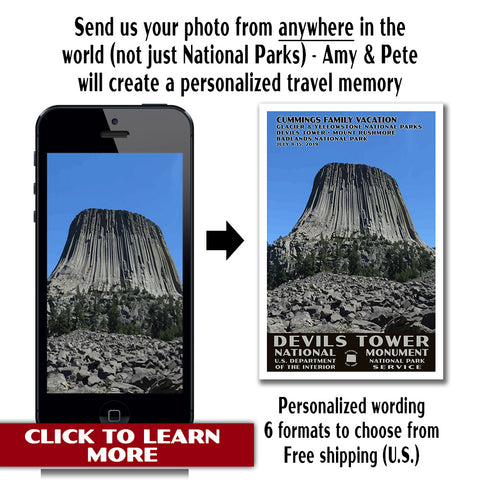
Devils Tower National Monument: Things to Do, Hiking Trails, Maps, Fees & More
Peter BrahanIf you are heading to visit the National Parks of Wyoming and the Dakotas, then making a stop at Devils Tower National Monument is something that you need to do. While it’s a small property for the National Park Service (relatively speaking), there is plenty to keep you intrigued here for a day. And if you have the time, then staying in the area is a great option as well.
Devils Tower is an imposing natural landmark, standing high above the surrounding Wyoming landscape. Rarely will you find yourself staring up at the sky so frequently as you will when you walk around the monument!
We visited this park in the summer and had an amazing time and are sure you will too. We hope our guide will help you better prepare for your visit so you can have a great time at Devils Tower National Monument!
Ahead of your trip, be sure to download a copy of our Devils Tower National Monument itinerary. We cover the best hikes, expected weather in the park, what to bring, what to see in the area, the best activities and sample 1, 2 and 3 day itineraries.
HOW WAS DEVILS TOWER FORMED?
There are several reports of how Devils Tower was formed. Histories passed down from many generations ago report that the tower was made from a bear making claw marks as it was trying to climb the rock. You can read about all the different narratives of how it was formed here.
Modern geologists have researched and believe that the Devils Tower was formed from underground molten rock which pushed up into surrounding sedimentary rock. The outside rock has simply eroded away (over thousands of years) to reveal the tower.
However it was formed, Devils Tower is considered to be sacred by American Indian tribes, and when you visit you should be respectful of what this area means to the descendants of those inhabitants who were in the area long before westerners came in.

DEVILS TOWER NATIONAL MONUMENT HISTORY
Devils Tower was the first National Monument and was designated in 1906 by President Theodore Roosevelt. But even before then, the landmark was a popular camping and day-trip spot for locals.
THINGS TO DO IN DEVILS TOWER NATIONAL MONUMENT
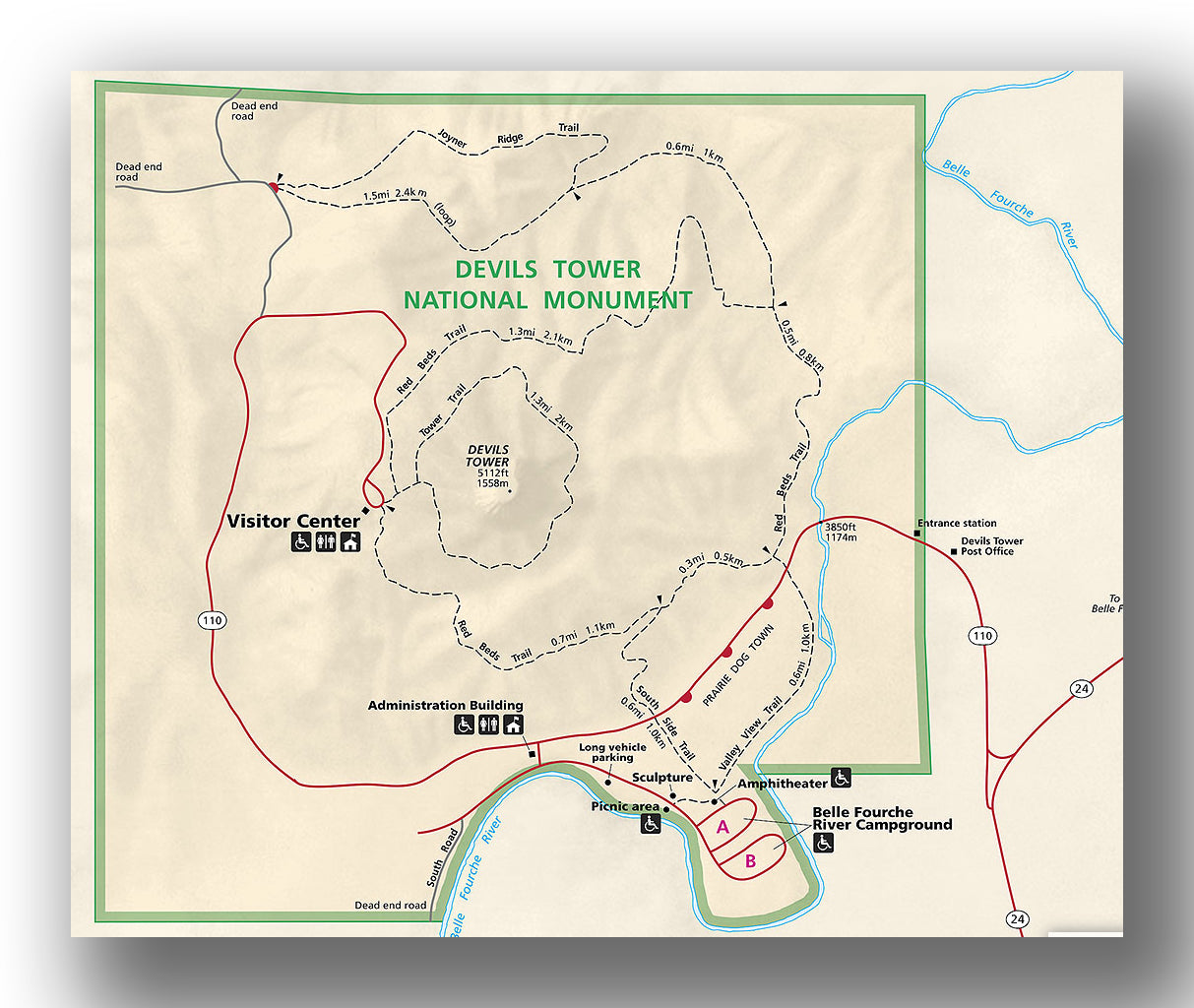
Devils Tower National Monument map, courtesy of the National Park Service
Neatly all the activities in monument revolve around Devils Tower itself. There are a couple exceptions, but it’s the main feature highlighted in most of the things to do in the park. While visiting, our recommendations include:
Devils Tower Visitor Center
Built in 1935 by the Civilian Conservation Corps, the visitor center resembles more of a log cabin than some of the more modern visitor centers. What it lacks in size it more than makes up for in character and content. Inside you’ll find great (and recently expanded) exhibits about the history of the area, as well as a great bookstore. Of course, while you are here you can discuss your visit with the rangers, who you may also find while you are out exploring the park.
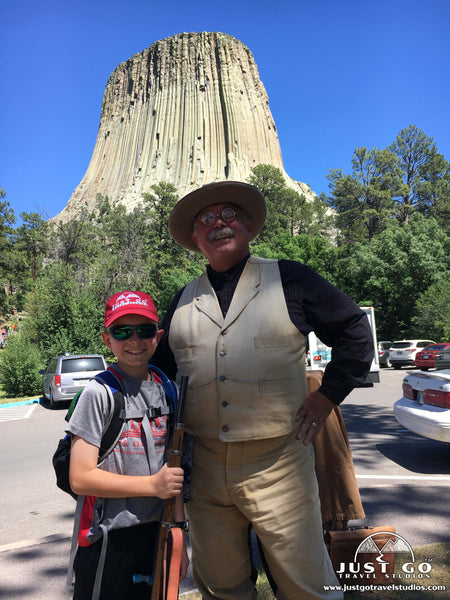
Picnicking
Near the campaign area is the Belle Fourche River hub, which has a ton of picnic tables (some of them are even covered). It’s a great area to spend a few hours if you need a break from your travels as well.
View the Prairie Dog area
The large prairie dog town has hundreds of prairie dogs that can be viewed from your car. Our kids loved watching and it kept us intrigued for quite some time! You can also hike around the prairie dog town on the Valley View and South Side Trails (see below).
Attend a Ranger Program
Ranger programs are offered in the summertime on various topics. Check out the calendar for the latest information.
Climbing
As you can imagine, climbing Devils Tower is quite popular. Registration is required at the beginning of the trail by filling out a card. There are 31 climbing routes to choose from, and they take typically between four and six hours. Climbing is not allowed in June, in observance of Native American cultural ceremonies.
Hiking
There are only a few hiking trails at the monument. All provide great views of Devils Tower and are of varying lengths and difficulties. In addition, it’s possible to combine trails if you have the time. We cover all the details and maps on hiking in the park in the next section.
HIKING TRAILS IN DEVILS TOWER NATIONAL MONUMENT
Devils Tower Trail
- Difficulty: Easy
- Distance (round-trip): 1.7 miles
- Elevation gain: 160 feet
- Hiking time (approximate): 1 hour

Devils Tower Trail map, courtesy of the National Park Service
The Devils Tower Trail is by far the most popular hiking trail in the park. The trail is a 1.7-mile loop that circumnavigates Devil’s Tower. There is also minimal elevation gain, at only about 160 feet, with the only steep section being on the way into the trail. The trail is completely paved, making it an easy walk for anyone that has about an hour on their hands. Along the way you’ll have great, close-up views of climbers, Devils Tower and get sweeping views of the surrounding landscape. The only downside of this trail is that it can get crowded.
To get to the Devils Tower Trail, head to the visitor center and go across the parking area.
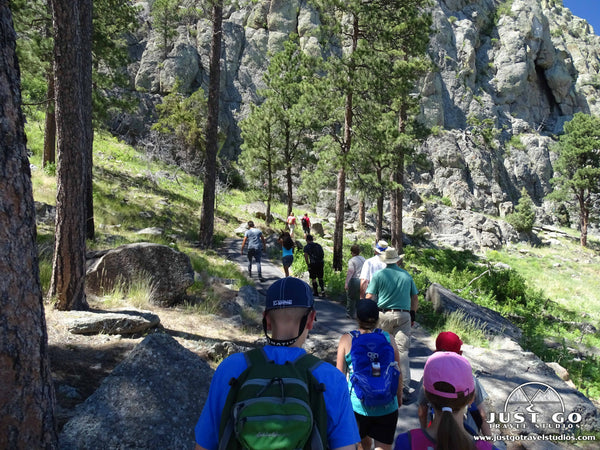
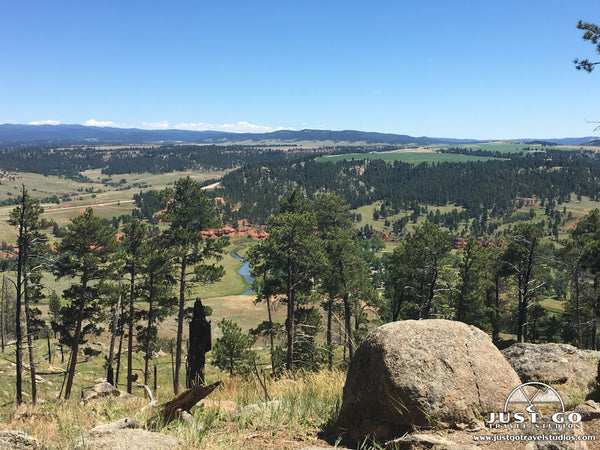

Red Beds Trail
- Difficulty: Easy / Moderate
- Distance (round-trip): 2.9 miles
- Elevation gain: 440 feet
- Hiking time (approximate):5 hours

Red Beds Trail map, courtesy of the National Park Service
For a bit of a longer hike the Red Beds Trail is a good option. This 2.9-mile loop also circumnavigates Devils Tower, but from a greater distance. The elevation gain is about 440 feet. It also has great views of the Belle Forche River Valley, and good views of Devils Tower, though it’s not as up-close and personal as the Tower Trail. The trail is packed dirt, but it can be muddy if there have been recent rains.
The Red Beds Trail begins from the visitor center parking area. Instead of heading directly toward the tower, head around the tower and follow the signs.
Joyner Ridge Trail
- Difficulty: Easy
- Distance (round-trip): 1.5 miles
- Elevation gain: 225 feet
- Hiking time (approximate): 1 hour

To stay away from the crowds, the Joyner Ridge Trail is a good option. This moderate hike is only 1.5-miles total and is a loop that only climbs about 225 feet in elevation. If you want to get the uphill over with quickly, then go counterclockwise. The steep hill happens at the halfway point. You get to see a lot of wildflowers and good views of Devils Tower. This trail is particularly good in the early morning-it’s very peaceful and almost a surreal experience.
The Joyner Ridge Trail is reached by heading to the Joyner Ridge trail parking, which is reached by driving on West Road (on the north side of Devils Tower National Monument Road) for about 0.4 miles.
South Side Trail
- Difficulty: Easy
- Distance (round-trip): 1.4 miles
- Elevation gain: 200 feet
- Hiking time (approximate): 1 hour

South Side Trail map, courtesy of the National Park Service
Another easy option is the South Side Trail. This 1.4-mile loop climbs a bit over 200 feet as it travels around the Prairie Dog Town. There is one road crossing and the trail is very exposed, so be ready for that.
The South Side Trail starts at the Amphitheater, which is near the campground.
HOW TO GET TO DEVILS TOWER NATIONAL MONUMENT AND OTHER TRAVEL INFORMATION
Devils Tower National Monument is in the northeastern corner of Wyoming. It really isn’t conveniently located near much and requires a bit of out-of-the-way driving, but it’s worth it! While you may not make this a destination to end your trip, it’s great to couple it with a trip to Yellowstone National Park, Badlands National Park, Custer State Park or the Rapid City area.
- Here are directions from Rapid City to Devils Tower National Monument. This will take nearly two hours.
- If you are coming from the west, here are directions from Yellowstone National Park to Devils Tower National Monument. This will take about 7 hours.
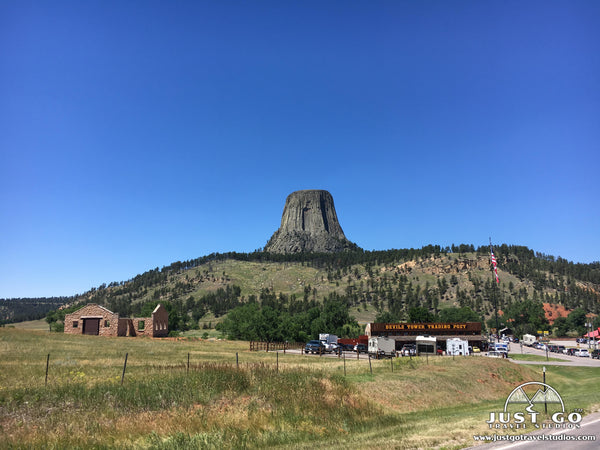
ENTRANCE FEES AND REQUIRED PASSES FOR DEVILS TOWER NATIONAL MONUMENT
An entrance fee is required for Devils Tower, and it’s on the more expensive side at over $20 per vehicle. You can also get an Annual Pass to the monument, or a National Park Interagency Pass.
WHERE TO STAY IN DEVILS TOWER NATIONAL MONUMENT
Devils Tower National Monument Lodging: There are no hotels or inns inside of Devils Tower National Monument. A good option is nearby Hulett, WY, which is about 10 miles to the north on Highway 24. We also recommend staying in Rapid City, which is about 2 hours away.
DEVILS TOWER NATIONAL MONUMENT CAMPING
Camping in Devils Tower National Monument is a great idea. In the evening, the stars in this part of Wyoming are amazing. There is only one option for camping inside of Devils Tower, but several campgrounds outside of the park.
To see a bit more on camping in the park, check out our blog on Camping in Devils Tower National Monument.
BEST TIME TO VISIT DEVILS TOWER NATIONAL MONUMENT
Devils Tower National Monument is open year-round, but the visitor center and the bookstore are only opened on a limited basis during the off season (between mid-October to mid-May). During the summer months, the park is fully open.

The park is very busy in the summer months, with over 500,000 people coming to visit each year. Each year this seems to grow, so you should be prepared for waits at the front entrance station and challenges with parking if you come during the middle of the day.
The weather in the summer here is warm and it will get hot while you are on the trails.
VISITING DEVILS TOWER NATIONAL MONUMENT IN THE WINTER
The park is open all year-round, but if you come in the winter you need to expect to see icy or snow-covered trails. Be sure to bring trekking poles, snowshoes and/or micro-spikes to avoid getting injured.
If you do come in the winter, it’s likely you’ll have most of the park to yourself, which can be an amazing experience!
ARE PETS ALLOWED IN DEVILS TOWER NATIONAL MONUMENT?
Pets can be brought to the monument, but they are not are allowed on trails or on the Tower itself. You must keep them leashed in developed areas only.

RELATED INFORMATION ON DEVILS TOWER NATIONAL MONUMENT AND THE SURROUNDING AREA FROM JUST GO TRAVEL STUDIOS
- Be sure to download a copy of our Devils Tower National Monument itinerary ahead of your trip! You also will want to check out our blog on Camping in Devils Tower National Monument.
- We recommend exploring the many nearby South Dakota locations when visiting Devils Tower, such as Custer State Park, Mount Rushmore, Badlands National Park and Wind Cave National Park. You could easily spend a week in the area!
- If you love National Park art, then consider picking up our Devils Tower National Monument WPA poster.
- Finally, we will work with you to take a photo that you send us and turn it into a custom, vintage-style travel poster. We know you’ll love it!



